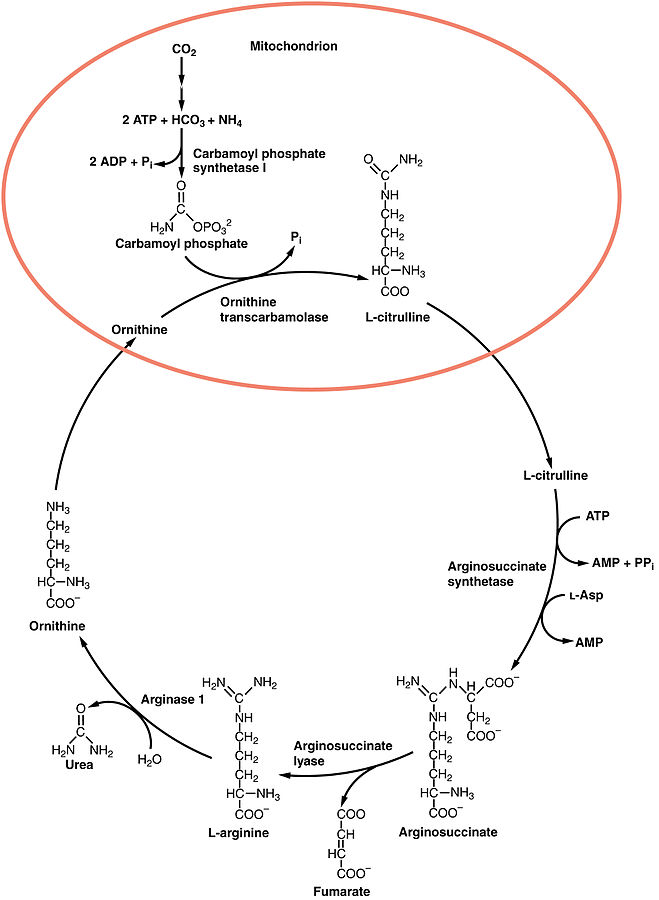
Conversion of ammonia to urea is done by ______ cycle.
A. Ornithine
B. Arginine
C. Fumaric
D. Citrulline
Answer
447.3k+ views
Hint: We have to know that in nearly $80\% $ of the nitrogen excreted by humans and mammals is in the form of urea, formed by a series of reactions occurring in the liver cell cytosol and mitochondrial matrix. T. Ammonia is a harmful result of the metabolism of nitrogen that should be eliminated from our bodies.
Complete answer:
We have to know that the urea cycle or ornithine cycle in the mitochondria of liver cells converts surplus ammonia into urea. The urea forms, is purified by the kidneys, then enters the circulatory system, and is ultimately excreted in the urine.The comprehensive answer to the formation of urea from ammonia is as follows:
$2Ammonia + C{O_2} + 3ATP \to Urea + Water + 3ADP$
In humans and mammals, urea is the main end product of nitrogen metabolism. The product of oxidative deamination reactions, ammonia, is poisonous in even small quantities and must be extracted from the body. The conversion reactions of ammonia into urea are described by the urea cycle or ornithine cycle. The urea is then transferred to the kidneys, where it is excreted, as these reactions occur in the liver.Hence, option A is the right option.

Hence, the correct answer is option (A).
Note: The main aim of the cycle of ornithine is to eliminate the body from toxic ammonia. Every day, roughly $10g$ to $20g$ of ammonia is eliminated from the body of a healthy adult. A period of dysfunctional urea will mean that the body has an excess amount of ammonia that can contribute to hyperammonemia and associated diseases. The deficiency in the urea cycle of one or more of the main enzymes that catalyze different reactions may cause cycle-related disorders.
Complete answer:
We have to know that the urea cycle or ornithine cycle in the mitochondria of liver cells converts surplus ammonia into urea. The urea forms, is purified by the kidneys, then enters the circulatory system, and is ultimately excreted in the urine.The comprehensive answer to the formation of urea from ammonia is as follows:
$2Ammonia + C{O_2} + 3ATP \to Urea + Water + 3ADP$
In humans and mammals, urea is the main end product of nitrogen metabolism. The product of oxidative deamination reactions, ammonia, is poisonous in even small quantities and must be extracted from the body. The conversion reactions of ammonia into urea are described by the urea cycle or ornithine cycle. The urea is then transferred to the kidneys, where it is excreted, as these reactions occur in the liver.Hence, option A is the right option.

Hence, the correct answer is option (A).
Note: The main aim of the cycle of ornithine is to eliminate the body from toxic ammonia. Every day, roughly $10g$ to $20g$ of ammonia is eliminated from the body of a healthy adult. A period of dysfunctional urea will mean that the body has an excess amount of ammonia that can contribute to hyperammonemia and associated diseases. The deficiency in the urea cycle of one or more of the main enzymes that catalyze different reactions may cause cycle-related disorders.
Recently Updated Pages
Master Class 12 Economics: Engaging Questions & Answers for Success

Master Class 12 Maths: Engaging Questions & Answers for Success

Master Class 12 Biology: Engaging Questions & Answers for Success

Master Class 12 Physics: Engaging Questions & Answers for Success

Master Class 12 Business Studies: Engaging Questions & Answers for Success

Master Class 12 English: Engaging Questions & Answers for Success

Trending doubts
Which are the Top 10 Largest Countries of the World?

Differentiate between homogeneous and heterogeneous class 12 chemistry CBSE

Draw a labelled sketch of the human eye class 12 physics CBSE

What is a transformer Explain the principle construction class 12 physics CBSE

What are the major means of transport Explain each class 12 social science CBSE

What is the Full Form of PVC, PET, HDPE, LDPE, PP and PS ?




